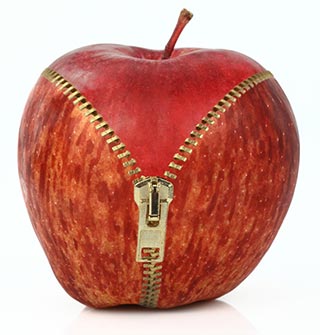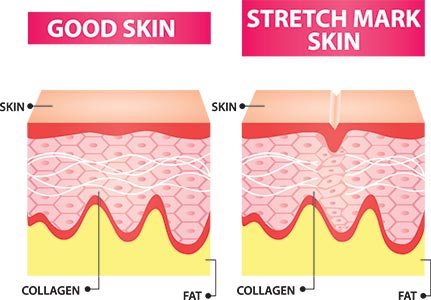How Are Stretch Marks Formed?
If you wish to get rid of stretch marks, it's essential to understand how they're formed. The skin is made of 3 layers - outer, middle and inner. The outer layer, also known as the epidermis, acts as a barrier thanks to the presence of flat cells, while the innermost layer of skin, also known as hypodermis, consists of fat and tissue. The middle layer, or the dermis, is the supportive layer that provides flexibility and firmness to the skin. It's the middle layer in which stretch marks develop due to rapid growth.
Initially when stretch marks are formed, they develop as indented streaks or lines in the middle layer of the skin. They slowly turn into multiple pink, red or purple streaks. As the marks grow older, they fade to a light pink, white or grey colour. All the marks grow through these stages and can often be considered unsightly.
What Causes Stretch Marks?
Stretch marks, often associated with pregnancy, occur mostly in women. However, it would be wrong to say that men are immune to them. Men do get stretch marks, but they're not as common as they are in women. There's no denying that pregnancy remains the biggest cause of stretch marks. About 90% women are affected by stretch marks during pregnancy. However, these marks can develop whenever a sudden growth spurt is experienced by the body, which is why many teenagers develop stretch marks on shoulders, upper arms and thighs at the time of puberty when their body grows suddenly. Sudden weight loss and weight gain can also leave such marks on the body. Deficiency of zinc can also lead to stretch marks as the mineral is responsible for the regeneration of the skin.
How To Prevent Stretch Marks
Before the unsightly tiger stripes start appearing, you can take control. Whilst sudden weight gain or weight loss isn’t always in your control, implementing a few simple everyday habits and using skin rejuvenating products can help you prevent or get rid of stretch marks.
- Drinking water helps the skin retain elasticity and can prevent stretch marks. You should drink about 13 cups of water during breastfeeding and at least 10 during pregnancy to help get rid of stretch marks.
- Add zinc-rich foods such as beef, spinach and pumpkin seeds to your diet for regenerating and repairing the skin and preventing stretch marks.
- When exercising to lose weight, work on toning the body fat too. This will ensure firmer skin and lesser stretch marks.
- Keeping skin moisturised won't prevent stretch marks completely but may help in making your skin look fresher and thus fade the unsightly stripes.
- Using good quality stretch mark oils and creams during the early stages of pregnancy can prevent stretch marks from becoming permanent. These products can minimise the skin's damage to some extent and can also help to get rid of stretch marks.
- Avoid crash diets designed to help you lose weight suddenly. Following a healthy diet and regular exercise routine to lose weight won't cause a sporadic change in your shape and thus lead to fewer and lighter stretch marks.
How To Get Rid Of Stretch Marks

Although stretch marks don’t pose any health risk, it's the cosmetic appearance of these marks that forces many men and women to seek treatment. Solutions to get rid of stretch marks basically depend on its current stage. One of the biggest risks of cosmetic procedures is scarring which can leave permanent marks that are far worse than stretch marks. It's also an expensive procedure with no guaranteed results. Here are some simpler ways that can help you get rid of stretch marks:
Laser treatment:
Fresh marks, i.e. indented streaks which develop immediately after pregnancy and growth spurts, can be removed using laser treatment. A laser is quite effective to get rid of stretch marks if the marks are just fine lines as the light penetrates the skin and stimulates collagen production. When marks get older and turn white and grey, it can be a bit harder to get rid of them. Although you can’t get rid of stretch marks completely, you can reduce their appearance by laser treatment and microdermabrasion. More than 2 to 3 sessions of the therapies will be required to notice significant improvement.
Creams & lotions:
Over-the-counter retinol creams are also helpful in improving the skin condition. But, if you're breastfeeding, don't use retinol creams as they're believed to cause birth defects. Not all creams, lotions or oils can be absorbed in the deep layers. However, certain products are formulated especially for this purpose and show better effects than others to get rid of stretch marks.
After your marks are properly visible i.e. when they turn pink and red, you can use firming formulations to restore the look of your skin. There are topical creams that contain natural ingredients such as Shea Butter, Aloe Vera, and Cocoa Butter which provide essential moisture to help make skin firm. You can also try using skin lightening creams for better complexion.
Derma rolling:
Micro needling is another technique to help get rid of stretch marks and derma rollers is one of the main popular options. The tiny needles when rolled on the skin help boost collagen production to make the skin appear new and refreshed. This has a lightening effect which helps fade them with regular usage and thus potentially get rid of stretch marks.
Diet:
Stretch marks can fade with time if you start addressing the cause early. Adding foods that boost cell regeneration in the skin can help speed up the process. Vitamin D rich foods like tuna, swordfish, or eggs can rebuild damaged skin whilst turkey, nuts and zinc rich fish can aid skin repair. These, if consumed regularly, can help get rid of stretch marks with time.
The Final Word
Can you erase or get rid of stretch marks? Whilst it's an ongoing debate, the easiest way to deal with stretch marks is to either avoid them or use products or methods that can help fade them. Stretch marks creams and lotions help boost collagen levels, hydrate the skin and thus minimise the appearance and help get rid of stretch marks for an even tone.


